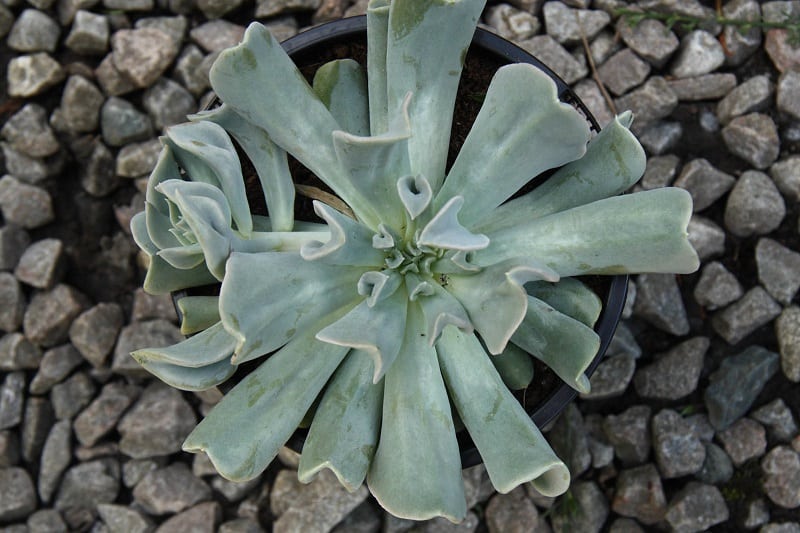In previous publications I have described a species of the genus Echeveria very popular in the gardens of the world In this publication, I will refer to a plant of the same genus, which has gained great fame for collectors due to the peculiar shape of its leaves; This plant is Echeveria Runyonii.
Echeveria runyonii, a very particular succulent plant.
Echeveria runyonii is characterized by being a medium-sized plant (10-25 cm in diameter) and leaf growth (leaves) arranged in rosette.
The leaves are elongated and curved towards the center of the plant.
These also have arched side edges that form a very evident ventral groove.
The leaves are usually greenish-gray but in some cases, they tend to take bluish colors.
The youngest leaves arise from the center of the plant just like all the Echeveria species.
Each leaf has at its apical end a spine-like structure that is not, this structure is a small extension of the leaf itself.
The rosette form in the plant never becomes perfect due to the narrowness of its leaves, so far I have not found a plant that has the distribution of its symmetrical leaves.
The flowers in this species are showier than most of the Echeveria species I know.
These can have orange, red or pink colors.
These are arranged in a cluster that emerges from the sides of the plant.
The clusters can be 1-2 per plant and can reach more than 30 cm in height (the stem that holds the floral cluster).
The stem that carries the floral cluster has smaller leaves than the leaves of the base.
Flowering occurs in the warmest times of the year (May-September).
Some mutations have been obtained from this species, giving rise to a much larger plant and with more abundant blooms.
Echeveria runyonii is native to Mexico but has been distributed to many countries of the world commercially.
It is a succulent very admired by collectors for the peculiar shape of its leaves.
Tips to take care of the Echeveria Runyonii ‘Topsy Turvy’
This species, like most Echeveria species, is quite resistant and does not need much care.
But if we want to reproduce it easily, obtain annual blooms and the best development of our plant, we must take into account some aspects:
Illumination
This species needs a very bright environment although it can grow in the shade.
It is recommended to be very careful when exposing this plant directly to the sun because its leaves may burn occasionally.
The best place to locate this plant is a place where sunlight is filtered.
Avoid direct sun exposure on the hottest summer days.
Temperature
The ambient temperature must be maintained above 26 ° C throughout the year.
They can tolerate small periods of temperatures below 10 ° C but it is best to avoid exposing them to very low temperatures.
In my experience, this species prefers a warm environment with relatively fixed temperatures throughout the year.
Ventilation
It needs to be located in very ventilated places to avoid rot associated with permanent moisture and avoid the appearance of some pests.
Irrigation and Substrate
Like all Crassulaceae, it only needs to be watered when the substrate is completely dry.
It is a plant that supports dry seasons without problems (it only loses some leaves) but if we water it when it needs it will not give its best.
The substrate must have perfect drainage to prevent rot and asphyxiation of its root system.
The best substrate is a mixture of soil, pebbles, and sand.
Pots
It develops perfectly in pots made of clay or plastic.
These should be wider than deep.
Propagation
This plant reproduces vegetatively very easily.
It can be of two forms: The first is to cut with a sharp object (sterilized) a well-developed leaf and bury only its base in a substrate very similar to the original, there should be a lot of lighting and only water when roots appear.
The second way is to carefully extract the children that appear at the base of the mother plant and sow them in separate pots.
Only extract children when they are quite large.
Plagues and diseases
The pests that most attack this plant are aphids (aphids), slugs and snails that, in extreme cases, can dry the plant completely.
To remove slugs and snails in a simple way, just sprinkle freshly crushed eggshell around the plant.
To remove aphids you can use cotton soaked in alcohol and rub it where they are. Another method is to use insecticides (I prefer alcohol).
Conclusion
This Echeveria, like many other succulent plants, is resistant to drought, although it develops best with frequent watering during hot periods; in winter it hardly requires irrigation, only sporadically.
Towards the end of the summer, it produces a long arched floral stalk, which rises above the plant, the small flowers are deep orange and yellow.
The flowers last in the bush for a long periods.
